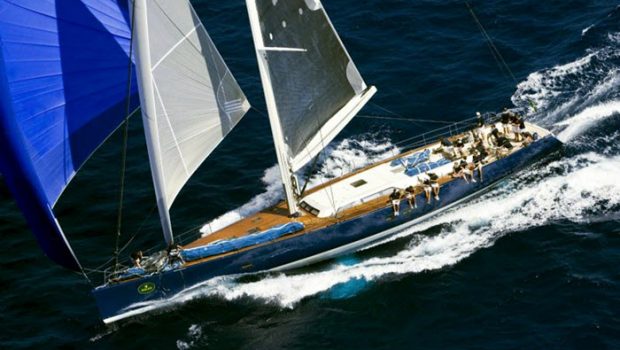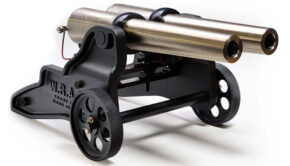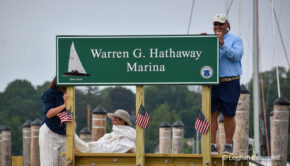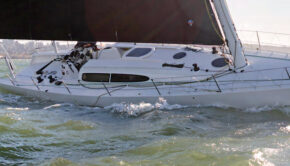The Cost of Grand Prix Yachting
Published on May 21st, 2018
Rob Weiland, who is the TP52 and Maxi72 class manager, expands our minds with the comparative costs amid the grand prix yachting in our sport. Because, why buy 475 J/70s when the same amount gets you the sweetest high performance superyacht roaming the Mediterranean Sea? From Seahorse Magazine:
It is vulgar to write about money but sometimes it helps to provide a perspective. In terms of build cost, a new 100-ft Wallycento roughly represents three Maxi72s, or 10 TP52s, or 25 Fast40s. The complete team including shore staff to go yachting at this level represents a baseline of 30 people for the Wallycento, 25 for the Maxi72, 16 for the TP52, and 12 for the Fast40.
One could conclude that the smaller the boat, the relatively more one spends on crew. Just pin an average number per day per crew member, why not 800 euro for fee/food/travel/accommodation/clothing and multiply it by the number of sailing days and number of crew per year.
Guess the Cento sails the least events, maybe 4 or 5, but will have a rather large permanent crew to cater for. A Maxi72 or TP52 soon clocks up 6 events at 8 sailing days each; the 72s usually have more training days but also have some offshores in the mix, typically something like four or five training days before racing starts where the TPs are restrained to 3 by the 52 Super Series rules.
The Fast40s race more but at shorter events and I guess clock up less sailing days than their bigger sisters. Certainly the Fast40s being based so far in one area (the Solent) and having most crew living in the UK helps to restrain spending, although the UK is not a cheap place to have a boat and go yachting.
Sails… winners love to spend on the motor and it really makes a difference. The cost of a complete set of new Wallycento rags will be impressive; the mainsail alone about equals a full set for a TP52 sails, but so far the Centos are not replacing sails like the 72s or the 52s.
Let’s say the Wallycento and Maxi72 budget for annually replacing sails is well over one million euros per year, the 52 Super Series TP52s spend at least 350,000-400,000 euro apiece and for the top 5 of the Fast40s, I take a stab at 100,000-160,000 euros?
Related to the miles sailed per year, boats racing offshores spend relatively less but need more specific reaching sails, which are an expensive commodity certainly when measured by the amount of use.
What am I trying to communicate? That it is a better investment to go bigger? Certainly not, just try to sell the love of your sailing life and be confronted with her secondhand value… Then the smaller less expensive boats obviously have a larger market and the TP52, without having made a full study of the last 10 years of trade, seem the best-selling small big boat, or if you wish, big small boat.
TP52s generally find a new owner within six months, finding a recent boat is already a plus and you won’t pay give-away rates which is quite encouraging. Depreciation of a new 2017-build TP52 over the first three years can be pinned down at about 500,000 euros per year. Thereafter, about 100,000 euros per year for the next three years assuming one bought a three-year-old boat at about 850-900,000 euros.
Those second three years probably offer the best balance of performance for the buck, but then I ignore the ‘importance of winning’. All the original equipment will still be functioning well and be reasonably up to date.
From six years onwards, for sure one buys a budget big boat, but every serious item you replace costs a measurable percentage of what the boat cost you. Buy old racers because they are ‘cheap’ but also buy them because you love to take care of boats. You will be rewarded by the boat as well as by the admiration of sailors and sailing fans who fell in love with her over the years and appreciate your efforts.
The above new build and depreciation comparison also explains the shift of one-off boatbuilding toward ever bigger boats. It is hard to find a continuous flow of work and make a profit in building one-offs in the smaller size range – a reason why construction prices for these smaller custom designs rose well above inflation over the past decade.
Consequently, smaller one-offs now often get built by builders set up to build much bigger boats and consequently with bigger overheads. Yards set up to build short runs of 40-50ft racing boats at close to one-off standards are a logical development in order to achieve lower prices but we are unlikely to see this without many more boats to build.
So the trend is clear, building and racing one-off racing boats will continue to see a focus on ever bigger boats. Also the TP52, sooner or later, will be too small a boat to sustain as a pure one-off. Already sharing moulds is quite common and from there it is a small step to greater streamlining of production.
Note: Seahorse, the dominant international magazine for anyone serious about their racing, is available by magazine subscription or iPad download: www.seahorse.co.uk/shop








 We’ll keep your information safe.
We’ll keep your information safe.